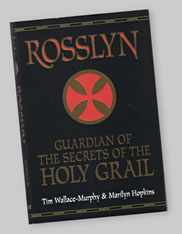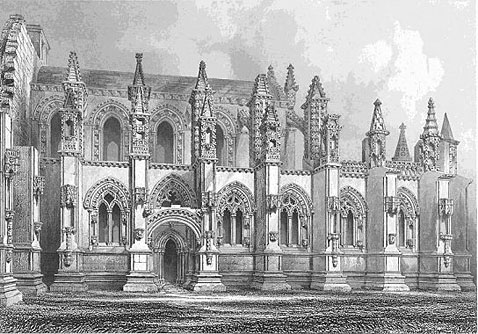|

|
Based on Marilyn Hopkins' dowsing abilities and Tim Wallace-Murphy’s fanciful understanding of the Knights Templar, these authors claim that Rosslyn Chapel, once a sacred Druidic site, was built by the Knights Templar to contain a coded guide to gnostic teachings. They claim much, provide little detail and prove nothing.
|
|
|
|

Rosslyn, Guardians of the Holy Grail
a few observations
by Trevor W. McKeown
|
|
Assertion is not proof. And unproven assertions, no matter how often they are repeated, are still unproven. In "Rosslyn, Guardian of the Secrets of the Holy Grail", Tim Wallace-Murphy and Marilyn Hopkins claim that the chapel, "once used by the Druids as the oracle of Saturn," was built by the Knights Templar to preserve the secret of the Holy Grail, to store the Ark of the Covenant, to preserve "a coded guide to gnostic teachings"; that it was "a storehouse of secret coded Templar information", "a hymn to Templar ideals" and a source of "coded teaching for Rosicrucianism and Freemasonry."
If the reader accepts dowsing and prayer as legitimate techniques for historical research, then this book will satisfy. But if any level of academic rigor is expected, the reader will be sore disappointed.
What authorities do they cite? While much of the argument hinges on the history of the Templars, of the great scholarly works on the Order by Marie Luise Bulst-Theile, Alain Demurger, Alan Forey, Helen Nicholson, and Malcolm Barber, only Barber is cited, and even then the single reference is distorted. Their footnoted citations are, in the main, Wallace-Murphy’s own earlier writings; the opinions of Trevor Ravenscroft, who has been proven to have fabricated evidence; the claims of Chris Knight and Robert Lomas, who failed to provide either proof or logical coherency in their own writings; the unrecognized claims of the self-styled Prince Michael of Albany and his promoter Laurence Gardner; and the tingling fingertips of Marilyn Hopkins.
Although they claim that "many scholars" or "most scholars" support their opinions, they fail to name names.
What facts do they present to bolster their claims? Few, beyond the physical reality of gothic architecture. On the other hand, the facts they claim without citation or proof are legion.
They start by describing the Knights Templar as heretical, yet the verdict of Pope Clement V did not find them guilty of heresy and the consensus of current scholarship is that there is no evidence of heretical activity or association. They repeatedly claim the Knights Templar were gnostic without providing any authority or proof of the claim. They claim that the five-pointed star was a Templar symbol yet fail to provide a single example other than Amiens Cathedral. Unfortunately, while this is used as an example of Templar symbolism, circuitously it is also used as proof of Templar influence in the cathedral’s construction.
They further claim that the five-pointed star was a symbol for Ishtar, yet fail to provide any examples. Not surprising since the eight-pointed star is identified with Ishtar, while five-pointed stars are practically unknown in Sumarian art.
Current scholarship is agreed that by the end of the thirteenth century the Templars were in decline. They were land rich and cash poor. A changing political and social climate had greatly reduced donations. Of the 15,000 members of the order in French territories, less than 5% were knights under arms while the greater majority were tradesman and farmers. Few spoke or wrote in other than their native language. The greater majority of their buildings were either donated or built by local labour and were designed to local patterns and needs. Their much vaunted fleet was composed of some four galleys. They were not monks.
Yet Wallace-Murphy and Hopkins insist that the order was wealthy, that the Templars were monks, that they had a "superb" fleet, and that they practiced sacred geometry. All without citation or proof.
They also have much to say about the Druids, ascribing to them many beliefs and practices that are not supported by the scanty historical record. They claim to understand the thinking of Earl William St Clair, who built Rosslyn Chapel, labeling him a gnostic and an Illuminati. They claim that Jesus was an Essene initiate. They claim that nearly all the founders of the Royal Society "were members of one or another of the hidden streams of spirituality." They claim much but prove little.
Like many authors in this genre, they pose hypothetical questions and then later write as if those questions had been answered in the affirmative. Almost every chapter ends with the claim that Rosslyn Chapel hides some deeper Templar secret yet nowhere are there any facts.
If the reader is prepared to accept that the Revelation of St John is "a kind of magic mirror" in which adepts can discern reflections of the past and future; if the reader is prepared to accept that the Templars’ ultimate objective was to "restore true gnostic monotheism to the world, uniting Christianity, Judaism and Islam"; if the reader is prepared to accept that Earl William St Clair gained the spiritual ability to look backwards and forwards through time; if the reader is prepared to accept that telluric power is "a form of terrestrial energy that can be located by dowsing" then perhaps the reader may be prepared to accept the opinions of Wallace-Murphy and Hopkins regarding Rosslyn Chapel.
While the pragmatic student of history will dismiss this book out of hand, the reader who already accepts the basic premise will equally be disappointed by the lack of details and specifics. The authors claim, "clearly recognizable Templar symbolism abound," but they fail to provide descriptions. They make frequent allusion to an "apocalyptic configuration" but don't give examples. They note a "coded sign on the wall of the crypt" without describing it. And on and on.
Wallace-Murphy and Hopkins may be right. Rosslyn Chapel may contain some Templar secret. But they haven't proved it by this book.
Rosslyn, Guardian of the Secrets of the Holy Grail, Tim Wallace-Murphy and Marilyn Hopkins. Shaftesbury, Dorset : Element Books Limited, 1999. ISBN: 1 86204 493 7. Cf.: "The Knights Templar in Scotland, The Creation of a Myth" by Robert L.D. Cooper, Ars Quatuor Coronatorum, vol. 115 (2002) London : Quatuor Coronati Lodge No. 2076, 2003. pp. 94-152.
|
|

